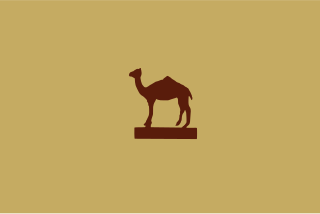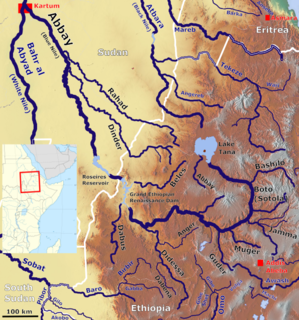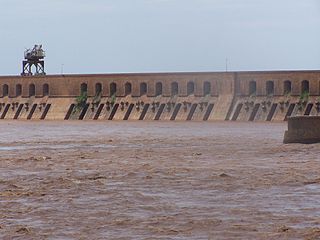Notes
- ↑ E.A. Robinson, "Nimr, the Last King of Shendi", Sudan Notes and Records, 8 (1925), p. 105.
Adlan II (died 1789) was the ruler of the Kingdom of Sennar (1776 - 1789).
He defeated the Vizier Rajab of Sennar and Fiki Haji Mohammed Majdub in the Battle of Taras in 1787. [1]

Sennar is a city on the Blue Nile in Sudan and possibly the capital of the state of Sennar. It remains publicly unclear whether Sennar or Singa is the capital of Sennar State. For several centuries it was the capital of the Funj Kingdom of Sennar.

Sennar is one of the 18 wilayat or states of Sudan. It has an area of 37,844 km² and a population of approximately 1,100,000 (2000).

The Funj Sultanate, also known as Funjistan, Sultanate of Sennar or Blue Sultanate due to the traditional Sudanese convention of referring to black people as blue was a monarchy in what is now Sudan, northwestern Eritrea and western Ethiopia. Founded in 1504 by the Funj people, it quickly converted to Islam, although this embrace was only nominal. Until a more orthodox Islam took hold in the 18th century, the state remained an "African empire with a Muslim façade". It reached its peak in the late 17th century, but declined and eventually fell apart in the 18th and 19th centuries. In 1821, the last sultan, greatly reduced in power, surrendered to the Ottoman Egyptian invasion without a fight.

Kordofan is a former province of central Sudan. In 1994 it was divided into three new federal states: North Kordofan, South Kordofan and West Kordofan. In August 2005, West Kordofan State was abolished and its territory divided between North and South Kordofan States, as part of the implementation of the Comprehensive Peace Agreement between the Government of Sudan and the Sudan People's Liberation Movement. West Kordofan was reestablished in July 2013.
Badi IV, also known as Badi abu Shilluk, was a ruler of the Kingdom of Sennar. He was the son of his predecessor, Nul.

The Islamization of the Sudan region (Sahel) encompasses a prolonged period of religious conversion, through military conquest and trade relations, spanning the 8th to 16th centuries.
Badi may refer to:
Er Roseires is a town in eastern Sudan 60 km from the border with Ethiopia.
Amara Dunqas was the first ruler of the Kingdom of Sennar, which he ruled from 1504 - 1533/4. "Dunqas" is an epithet meaning "bent down, with an inclined head", referring to the way of how he required his subjects to approach him.
The Battle of the Dindar River was fought near the Dinder River in 1738, between the forces of the Ethiopian Emperor Iyasu II and the Sennar army under King Badi IV. The battle was a disaster for the Ethiopians and for Iyasu.
Abd al-Qadir II was a ruler of the Kingdom of Sennar. According to James Bruce, he was the son of Unsa I, whom Bruce describes as "a weak and ill-inclined man". While he was ruler of Sennar, Emperor Susenyos of Ethiopia sent to Abd al-Qadir a nagarit, or kettle-drum, richly decorated with gold, which was one of the traditional emblems of an Ethiopian negus or king; in return, Abd al-Qadir sent Susenyos a trained hunting falcon. Shortly after this diplomatic exchange, he was deposed by his brother Adlan.

The Dinder River is a tributary of the Blue Nile. It flows through Ethiopia and Sudan for 480 kilometres (300 mi).

The Sennar Dam is an irrigation dam on the Blue Nile near the town of Sennar in the Al Jazirah region of Sudan. The dam is 3,025 metres (9,925 ft) long and has a maximum height of 40 metres (130 ft). It was designed by the Scottish engineer Sir Murdoch MacDonald, begun in 1914 and completed in 1925 by the British contractor S Pearson & Sons.
Badi I, also known as Badi el Kawam, was a ruler of the Kingdom of Sennar. During his reign, Sennar was at peace with its neighbor, Ethiopia. The Ethiopian Royal Chronicles mention that Emperor Susenyos of Ethiopia responded to the gift Badi's predecessor had sent him by sending to Sultan Badi bracelets of gold and a gold-mounted saddle.
Adlan I was a ruler of the Kingdom of Sennar. He was the son of Ayat, although James Bruce writes he was the son of Unsa I and the brother of Abd al-Qadir, whom he deposed and exiled from Sennar. Adlan was, in turn, deposed by his nephew Badi.
Sennar Airport is an airport serving Sennar in Sudan.

Nasir was a Hamaj regent under the Funj Sultanate of Sennar. He was the son of Badi IV, the previous ruler.
Singa is a town located in the Sennar State of Sudan at an elevation of 439 meters above sea level. The town is situated on the west bank of the Blue Nile at a distance of 360 kilometers to the southeast of the capital, Khartoum, and 60 kilometers from Sennar city. Its population was recorded to be 259,000 in 2002.

The Sudans is a region in Northeast Africa comprising the sovereign countries of Sudan and South Sudan. Until 2011, the region was united under a state known as the Republic of the Sudan.

The kingdom of Fazughli was a precolonial state in what is now southeastern Sudan and western Ethiopia. Oral traditions assert its establishment to refugees from the Nubian kingdom of Alodia, after its capital Soba had fallen to Arabs or the Funj in c. 1500. Centered around the mountainous region of Fazughli on the Blue Nile and serving as a buffer between the Funj sultanate and the Ethiopian empire, the kingdom lasted until its incorporation into the Funj sultanate in 1685.